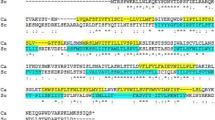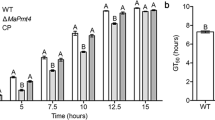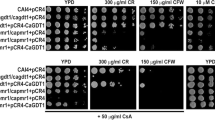Abstract
Glycosylphosphatidylinositol (GPI) is an important compound for the growth of fungi, because GPI-anchored proteins including glycosyltransferases and adhesins are involved in cell-wall integrity, adhesion, and nutrient uptake in this organism. In this study, we examined orf19.5244 in the genome database of the pathogenic fungus Candida albicans, a homologue of the Saccharomyces cerevisiae mannose–ethanolamine phosphotransferase gene, MCD4, which plays a role in GPI synthesis. Expression of this homologue, designated CaMCD4, restored cell growth in a defective conditional mcd4 mutant of S. cerevisiae, Scmcd4t, in which expression of native MCD4 was repressed in the presence of doxycycline (Dox). Analysis of radiolabeled lipids showed that the accumulation of abnormal GPI anchor precursors in Scmcd4t decreased markedly upon expression of CaMCD4. Moreover, we constructed a single mutant (Camcd4/CaMCD4) and a conditional double mutant (Camcd4/Camcd4t) at the MCD4 locus of C. albicans. Repression of CaMCD4 expression by Dox led to a decrease in growth and appearance of abnormal morphology in C. albicans, both in vitro and in a silkworm infection model. These results suggest that CaMcd4p is indispensable for growth of C. albicans both in vitro and in infected hosts and a candidate target for the development of new antifungals.






Similar content being viewed by others
References
Ausubel FM, Brent R, Kingston RE, Moore DD, Seidman JG, Smith JA, Struhl K (1992) Current protocols in molecular biology. Wiley, New York
Boeke JD, LaCroute F, Fink GR (1984) A positive selection for mutants lacking orotidine-5′-phosphate decarboxylase activity in yeast: 5-fluoro-orotic acid resistance. Mol Gen Genet 197:345–346
Chen X, Magee BB, Dawson D, Magee PT, Kumamoto CA (2004) Chromosome 1 trisomy compromises the virulence of Candida albicans. Mol Microbiol 51:551–565
Christianson TW, Sikorski RS, Dante M, Shero JH, Hieter P (1992) Multifunctional yeast high-copy-number shuttle vectors. Gene 110:119–122
Ferreira C, Silva S, Faria-Oliveira F, Pinho E, Henriques M, Lucas C (2010) Candida albicans virulence and drug-resistance requires the O-acyltransferase Gup1p. BMC Microbiol 10:238
Fonzi WA, Irwin MY (1993) Isogenic strain construction and gene mapping in Candida albicans. Genetics 134:717–728
Fujita M, Jigami Y (2008) Lipid remodeling of GPI-anchored proteins and its function. Biochim Biophys Acta 1780:410–420
Fujita M, Kinoshita T (2010) Structural remodeling of GPI anchors during biosynthesis and after attachment to proteins. FEBS Lett 584:1670–1677
Gaynor EC, Mondésert G, Grimme SJ, Reed SI, Orlean P, Emr SD (1999) MCD4 encodes a conserved endoplasmic reticulum membrane protein essential for glycosylphosphatidylinositol anchor synthesis in yeast. Mol Biol Cell 10:627–648
Grimme SJ, Colussi PA, Taron CH, Orlean P (2004) Deficiencies in the essential Smp3 mannosyltransferase block glycosylphosphatidylinositol assembly and lead to defects in growth and cell wall biogenesis in Candida albicans. Microbiology 150:3115–3128
Hanaoka N, Umeyama T, Ueno K, Ueda K, Beppu T, Fugo H, Uehara Y, Niimi M (2005) A putative dual-specific protein phosphatase encoded by YVH1 controls growth, filamentation and virulence in Candida albicans. Microbiology 151:2223–2232
Hanaoka N, Takano Y, Shibuya K, Fugo H, Uehara Y, Niimi M (2008) Identification of the putative protein phosphatase gene PTC1 as a virulence-related gene using a silkworm model of Candida albicans infection. Eukaryot Cell 7:1640–1648
Hong Y, Maeda Y, Watanabe R, Ohishi K, Mishkind M, Riezman H, Kinoshita T (1999) Pig-n, a mammalian homologue of yeast Mcd4p, is involved in transferring phosphoethanolamine to the first mannose of the glycosylphosphatidylinositol. J Biol Chem 274:35099–35106
Ikemura T (1985) Codon usage and tRNA content in unicellular and multicellular organisms. Mol Biol Evol 2:13–34
Imhof I, Canivenc-Gansel E, Meyer U, Conzelmann A (2000) Phosphatidylethanolamine is the donor of the phosphorylethanolamine linked to the alpha1,4-linked mannose of yeast GPI structures. Glycobiology 10:1271–1275
Kaneko A, Umeyama T, Hanaoka N, Monk BC, Uehara Y, Niimi M (2004) Tandem affinity purification of the Candida albicans septin protein complex. Yeast 21:1025–1033
Kinoshita T, Fujita M, Maeda Y (2008) Biosynthesis, remodelling and functions of mammalian GPI-anchored proteins: recent progress. J Biochem 144:287–294
Klis FM, Sosinska GJ, de Groot PW, Brul S (2009) Covalently linked cell wall proteins of Candida albicans and their role in fitness and virulence. FEMS Yeast Res 9:1013–1028
Kuwayama H, Obara S, Morio T, Katoh M, Urushihara H, Tanaka Y (2002) PCR-mediated generation of a gene disruption construct without the use of DNA ligase and plasmid vectors. Nucleic Acids Res 30:e2
Liu H, Köhler J, Fink GR (1994) Suppression of hyphal formation in Candida albicans by mutation of a STE12 homolog. Science 266:1723–1726
Liu W, Zou Z, Huang X, Shen H, He LJ, Chen SM, Li LP, Yan L, Zhang SQ, Zhang JD, Xu Z, Xu GT, An MM, Jiang YY (2016) Bst1 is required for Candida albicans infecting host via facilitating cell wall anchorage of Glycosylphosphatidyl inositol anchored proteins. Sci Rep 6:34854
Maeda Y, Kinoshita T (2011) Structural remodeling, trafficking and functions of glycosylphosphatidylinositol-anchored proteins. Prog Lipid Res 50:411–424
Maneesri J, Azuma M, Sakai Y, Igarashi K, Matsumoto T, Fukuda H, Kondo A, Ooshima H (2005) Deletion of MCD4 involved in glycosylphosphatidylinositol (GPI) anchor synthesis leads to an increase in β-1,6-glucan level and a decrease in GPI-anchored protein and mannan levels in the cell wall of Saccharomyces cerevisiae. J Biosci Bioeng 99:354–360
Mann PA, McLellan CA, Koseoglu S, Si Q, Kuzmin E, Flattery A, Harris G, Sher X, Murgolo N, Wang H, Devito K, de Pedro N, Genilloud O, Kahn JN, Jiang B, Costanzo M, Boone C, Garlisi CG, Lindquist S, Roemer T (2015) Chemical genomics-based antifungal drug discovery: targeting glycosylphosphatidylinositol (GPI) precursor biosynthesis. ACS Infect Dis 1:59–72
Mondésert G, Clarke DJ, Reed SI (1997) Identification of genes controlling growth polarity in the budding yeast Saccharomyces cerevisiae: a possible role of N-glycosylation and involvement of the exocyst complex. Genetics 147:421–434
Mortimer RK, Johnston JR (1986) Genealogy of principal strains of the yeast genetic stock center. Genetics 113:35–43
Murad AM, Lee PR, Broadbent ID, Barelle CJ, Brown AJ (2000) CIp10, an efficient and convenient integrating vector for Candida albicans. Yeast 16:325–327
Nagahashi S, Nakayama H, Hamada K, Yang H, Arisawa M, Kitada K (1997) Regulation by tetracycline of gene expression in Saccharomyces cerevisiae. Mol Gen Genet 255:372–375
Nakayama H, Izuta M, Nagahashi S, Sihta EY, Sato Y, Yamazaki T, Arisawa M, Kitada K (1998) A controllable gene-expression system for the pathogenic fungus Candida glabrata. Microbiology 144:2407–2415
Nakayama H, Mio T, Nagahashi S, Kokado M, Arisawa M, Aoki Y (2000) Tetracycline-regulatable system to tightly control gene expression in the pathogenic fungus Candida albicans. Infect Immun 68:6712–6719
Oura T, Kajiwara S (2008) Disruption of the sphingolipid Δ8-desaturase gene causes a delay in the morphological change of Candida albicans. Microbiology 154:3795–3803
Packeiser AN, Urakov VN, Polyakova YA, Shimanova NI, Shcherbukhin VD, Smirnov VN, Ter-Avanesyan MD (1999) A novel vacuolar protein encoded by SSU21/MCD4 is involved in cell wall integrity in yeast. Yeast 15:1485–1501
Paulick MG, Bertozzi CR (2008) The glycosylphosphatidylinositol anchor: a complex membrane-anchoring structure for proteins. Biochemistry 47:6991–7000
Pittet M, Conzelmann A (2007) Biosynthesis and function of GPI proteins in the yeast Saccharomyces cerevisiae. Biochim Biophys Acta 1771:405–420
Plaine A, Yáñez A, Murciano C, Gaillardin C, Gil ML, Richard ML, Gozalbo D (2008) Enhanced proinflammatory response to the Candida albicans gpi7 null mutant by murine cells. Microbes Infect 10:382–389
Richard ML, Plaine A (2007) Comprehensive analysis of glycosylphosphatidylinositol-anchored proteins in Candida albicans. Eukaryot Cell 6:119–133
Richard M, De Groot P, Courtin O, Poulain D, Klis F, Gaillardin C (2002) GPI7 affects cell-wall protein anchorage in Saccharomyces cerevisiae and Candida albicans. Microbiology 148:2125–2133
Rossignol T, Lechat P, Cuomo C, Zeng Q, Moszer I, d’Enfert C (2007) CandidaDB: a multi-genome database for Candida species and related Saccharomycotina. Nucleic Acids Res 36:D557–D561
Sambrook J, Fritsch EF, Maniatis T (1989) Molecular cloning: a labortory manual, 2nd edn. Cold Spring Harbor Laboratory Press, New York
Santos MA, Tuite MF (1995) The CUG codon is decoded in vivo as serine and not leucine in Candida albicans. Nucleic Acids Res 23:1481–1486
Sato K, Noda Y, Yoda K (2007) Pga1 is an essential component of Glycosylphosphatidylinositol-mannosyltransferase II of Saccharomyces cerevisiae. Mol Biol Cell 18:3472–3485
Sikorski RS, Hieter P (1989) A system of shuttle vectors and yeast host strains designed for efficient manipulation of DNA in Saccharomyces cerevisiae. Genetics 122:19–27
Umeyama T, Kaneko A, Nagai Y, Hanaoka N, Tanabe K, Takano Y, Niimi M, Uehara Y (2005) Candida albicans protein kinase CaHsl1p regulates cell elongation and virulence. Mol Microbiol 55:381–395
Victoria GS, Kumar P, Komath SS (2010) The Candida albicans homologue of PIG-P, CaGpi19p: gene dosage and role in growth and filamentation. Microbiology 156:3041–3051
Wiedman JM, Fabre AL, Taron BW, Taron CH, Orlean P (2007) In vivo characterization of the GPI assembly defect in yeast mcd4-174 mutants and bypass of the Mcd4p-dependent step in mcd4Δ cells. FEMS Yeast Res 7:78–83
Zhu Y, Vionnet C, Conzelmann A (2006) Ethanolaminephosphate side chain added to glycosylphosphatidylinositol (GPI) anchor by mcd4p is required for ceramide remodeling and forward transport of GPI proteins from endoplasmic reticulum to Golgi. J Biol Chem 281:19830–19839
Author information
Authors and Affiliations
Corresponding author
Ethics declarations
Conflict of interest
The authors declare that they have no conflict of interest.
Ethical approval
The procedures performed in studies involving animals were in accordance with the ethical standards of the institution and this article does not contain any studies with participants performed by any of the authors.
Additional information
Communicated by M. Kupiec.
Publisher's Note
Springer Nature remains neutral with regard to jurisdictional claims in published maps and institutional affiliations.
Electronic supplementary material
Below is the link to the electronic supplementary material.
294_2019_987_MOESM1_ESM.pptx
Supplemented Figure 1 Southern blot analysis of C. albicans transformants. The BglII-digested genome DNAs from TUA4, Camcd4::ARG4/CaMCD4, and Camcd4::ARG4/Camcd4::URA3 strains were used. The 0.5 kb DNA fragment corresponding to the 5’ end of CaMCD4 was amplified by PCR and used as a radiolabeled probe. The hybridization conditions were shown in “Methods”. Table 1 Strains used in this study. (PPTX 64 kb)
Rights and permissions
About this article
Cite this article
Hasegawa, S., Yamada, Y., Iwanami, N. et al. Identification and functional characterization of Candida albicans mannose–ethanolamine phosphotransferase (Mcd4p). Curr Genet 65, 1251–1261 (2019). https://doi.org/10.1007/s00294-019-00987-7
Received:
Revised:
Accepted:
Published:
Issue Date:
DOI: https://doi.org/10.1007/s00294-019-00987-7




